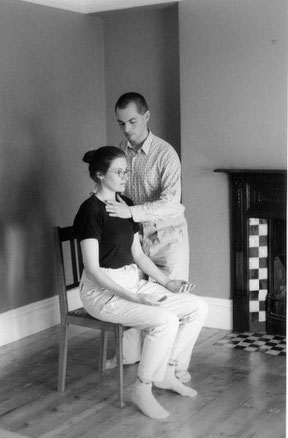DEFINING THE ALEXANDER TECHNIQUE Tim
Soar © 1999
7. Working on the Chair
Chairwork, the practice of working with a student standing, sitting and moving between these two activities, is a staple part of the Alexander Technique. It formed the mainstay of Alexander‘s own
teaching and it remains the most powerful and direct way to give a student the experience of going up.
Parents will recall that when children first learn to stand they practise the movement from squatting to standing and other similar exercises over and over again (often holding on to a piece of furniture for balance). This does more than merely strengthen the leg muscles; it establishes and reinforces the neuromuscular coordination required to allow the child to move in an integrated way, each part of the body working as part of a well organised whole, and developing the sense of balance to the level necessary for fully upright activity. A natural, easy, balanced pattern of movement is thus created, which coordinates the head, neck, back and legs, and the foundation is laid for all later upright activity from walking, running and jumping, through singing, dancing and bicycling to drawing and playing musical instruments.

The purpose of chairwork is to recapitulate this fundamental patterning of the neuromuscular system so that the maintenance of the processes of balance and movement and reaction to external
stimuli can become more maturely conscious and skilled and, in the process, more subtle and refined.
This self-aware maintenance of poise is the ultimate aim of the Alexander Technique. Alexander called it constructive conscious control of the individual, which he described as “a plane to be reached rather than a method of reaching it”.l In other words, the Alexander Technique is not a way of “doing things right” but rather a journey of self-discovery which demands an ongoing examination and, where appropriate, conscious modification of all our actions, habits and even thoughts.
Learn to look on chairwork as a means whereby2 you can learn to monitor and gradually improve your upright movements and sharpen your self-awareness, rather than a system for learning the right way to get in and out of a chair.
Chairwork has little to do with trying to sit down and stand up properly.
They will all see it as getting in and out of a chair the right way. It is nothing of the kind. It is that a pupil decides what he will or will not consent to do.3
A skilled teacher’s hands-on work may well have a direct therapeutic effect, but that is not its primary purpose. The main function of the hands is explanatory – informing your understanding as much as guiding your movements.
Therefore, in responding to your teacher’s hands during a lesson, and perhaps particularly during chairwork, aim to do so in the same way as you might listen to a careful verbal explanation.
A helpful analogy might be the idea of listening to music; everyone listens to music for pleasure, but musicians often have to listen analytically, in order to further their understanding. Similarly, you should enjoy the contact of your teacher’s hands, but stay alert and aim to be muscularly quiet enough that you can detect the nuances of the information so conveyed.
1 Constructive Conscious Control of the Individual, FM Alexander, 1923, Part 1 “Sensory Appreciation in Relation to Man’s Evolutionary Development”.
2 The phrase means whereby is often used to mean the opposite of endgaining. If one does not endgain towards a goal one pays attention to the means whereby that goal may be reached.
3 Alexander quoted in The Alexander Technique, The Essential Writings of F Matthias Alexander, Edward Maisel, 1969, Chapter 1 “Notes of Instruction”.